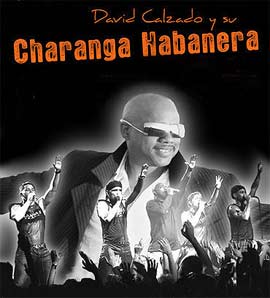Charanga Habanera Cuban orchestra and its fifteen years of fame
- Submitted by: admin
- Arts and Culture
- Culture and Traditions
- Entertainment
- Havana
- Music
- national
- personalities
- Society
- Personalities
- 01 / 03 / 2010

In 1994, the director of Cuba magazine asked me to go, somehow immediately, to the recently inaugurated “Palacio de la Salsa,” in the former Copa Room hall of Hotel Habana Riviera. The mission: to report on the excellent musical, dance and
gastronomic project.
Many people went there in those times of crisis, opening of tourism, and legalization of the dollar, after the collapse of Cuba’s commercial partners from East Europe.
The legalization of the foreign currency allowed the population to acquire products in diverse commercial centres emerging at the time, thus having an impact on the country’s socioeconomic conditions, as those with access to the dollar were in better
conditions to face the crisis.
Those were moments of happiness and sadness. Some people, like me, had the eyes fixed on a glass of mojito. But all of the sudden, the nice figure of director, composer, arranger, singer and dancer David Calzado appeared to change the state of affairs.
During the formal greeting, his personal details came to my mind. He was born late in the 1950s in Havana, son of Sergio Calzado, dancer and singer of the anthological band Fajardo y sus Estrellas. David graduated as violinist, along with
Rafelito Lay (Aragón Orchestra) and Tony Calá (NG La Banda).
He was member of Ritmo Oriental Orchestra, the marvellous brass band that challenged the people’s preference to Los Van Van orchestra in the 1970s.
David started saying: “Charanga Habanera emerged in 1988, when young, talented Cuban musicians graduated from Cuban school arts got together to develop a popular music project dating back to the 1940s and 50s, to fulfil a commitment at the Montecarlo Sporting Club.”
The Montecarlo Sporting!, a place well known by Cubans, because the Lecuona Cuban Boys and the Armando Oréfiche Orchestra performed there, with such eminent musicians as Rafael Somavilla, Leonardo Timor, and Yeyo Escalante.
The project was successful for five years. During that time, La Charanga shared stages with famous musicians such as Stevie Wonder, Donna Summer, Barry White, James Brown, Ray Charles, Frank Sinatra, Charles Aznavour, Jerry Lewis, Kool and the Gang, and Whitney Houston. They also recorded their first CD with DOM.
David Calzado told me the funny paradox that though his musicians -whom he called “my niggers”- are ugly, the brass band is considered by critics “an orchestra for women.”
The band had many virtues: the mastery of its musicians, the rich polyrhythm of percussion instruments, and easy, attractive lyrics, with choruses reflecting daily life in Cuba.
The director said proudly that famous Cuban musician Formell respected him, and envisaged a future of many tours.
Then, in the middle of the conversation, someone called him and maestro Calzado apologized with a smile and headed for the stage to prepare the show. The interview would continue afterwards.
I then realized that in another table, also enjoying what was happening at Palacio de la Salsa it was the “prince of heights,” Javier Sotomayor, who was then at the peak of his career after his 2.45-meter record in Salamanca. Jorge Perugorría, the main character of the film Fresa y Chocolate, was enjoying that night as well.
La Charanga was on the stage. Singer Leo Vera started with the song Pensar en ti, by Pancho Céspedes, and continued with Tú eres. The audience was singing together, dancing, and many girls threw their brassieres at the musicians. It was a steady show that closed with Yo no camino más, popularized by América Orchestra.
David then took up the interview, and asked me: How was it?” “Awesome”, I said. He then asked Perugorría, who replied: “This is the band that gives the most for show.” So it was. La Charanga, with its spectacular choreographies, heated up the audience’s adrenaline.
I finally told him: “You all have danced all through the performance, do you do physical training?” “Yes, sure,” he said.
What will you do when you get old? Could you maintain that rhythm? “I never think I will get old,” he said with a smile.
After 15 years, La Charanga Habanera is still on the crest of the wave, with a similar spectacle, which means they will remain like that for a long while.
In 1998, it won the award for most popular Cuban band, which they preserved in 1999, 2000, and 2001, despite many tours of Japan, Europe, Mexico, Argentina, Peru, the US, and northern Africa.
La Charanga Habanera was nominated to the Latin Grammy awards in 2003 with the disc Live in the USA, and in 2005 was nominated to the Orgullosamente Latino awards (Proudly Latin awards) in three categories: best video, best album, best group.
The band has also conquered spaces in the Cubadisco and Lucas awards in Cuba.
In addition, La Charanga has won a place within the Cuban Team of Timba, along with Juan Formell and Los Van Van (Timba and songo), Adalberto Álvarez (Timba and son), José Luis Cortés and NG La Banda (Timba and jazz), Manolín, el médico de la Salsa, (Timba and rap), and Paulo FG y su Elite (Timbaand and suffocation).
Another thing: Elio Revé has been always referred to as a musician with “good touch” to attract musical personalities (Chucho Valdés, Juan Formell, Puppy Pedroso, Juan Carlos González). But such excellent musicians as Leo Vera, Michel Maza, El Bony,
Dantes Cardosa and Leoni Torres have passed through La Charanga Habanera.
Among the songs that have made this miracle possible are: El Bony está pasmao, Riki ricón, Soy cubano, soy popular, Juana Magdalena, Chico caramelo, El Charanguero mayor, El temba, La carátula, Lola Lola and Gozando La Habana, the latest.
Source: www.cubanow.net
Comments